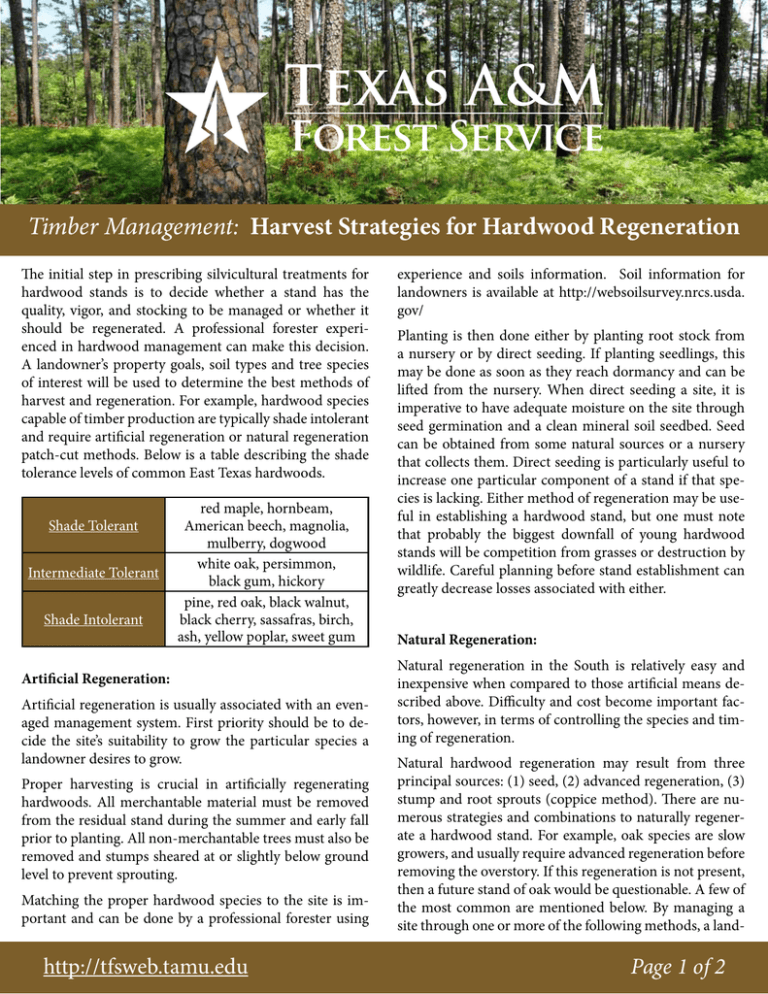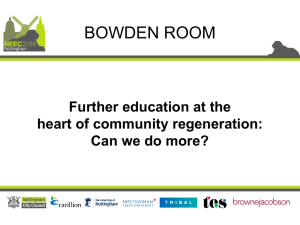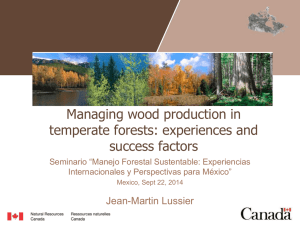Timber Management:
advertisement

Timber Management: Harvest Strategies for Hardwood Regeneration The initial step in prescribing silvicultural treatments for hardwood stands is to decide whether a stand has the quality, vigor, and stocking to be managed or whether it should be regenerated. A professional forester experienced in hardwood management can make this decision. A landowner’s property goals, soil types and tree species of interest will be used to determine the best methods of harvest and regeneration. For example, hardwood species capable of timber production are typically shade intolerant and require artificial regeneration or natural regeneration patch-cut methods. Below is a table describing the shade tolerance levels of common East Texas hardwoods. Shade Tolerant Intermediate Tolerant Shade Intolerant red maple, hornbeam, American beech, magnolia, mulberry, dogwood white oak, persimmon, black gum, hickory pine, red oak, black walnut, black cherry, sassafras, birch, ash, yellow poplar, sweet gum Artificial Regeneration: Artificial regeneration is usually associated with an evenaged management system. First priority should be to decide the site’s suitability to grow the particular species a landowner desires to grow. Proper harvesting is crucial in artificially regenerating hardwoods. All merchantable material must be removed from the residual stand during the summer and early fall prior to planting. All non-merchantable trees must also be removed and stumps sheared at or slightly below ground level to prevent sprouting. Matching the proper hardwood species to the site is important and can be done by a professional forester using http://tfsweb.tamu.edu experience and soils information. Soil information for landowners is available at http://websoilsurvey.nrcs.usda. gov/ Planting is then done either by planting root stock from a nursery or by direct seeding. If planting seedlings, this may be done as soon as they reach dormancy and can be lifted from the nursery. When direct seeding a site, it is imperative to have adequate moisture on the site through seed germination and a clean mineral soil seedbed. Seed can be obtained from some natural sources or a nursery that collects them. Direct seeding is particularly useful to increase one particular component of a stand if that species is lacking. Either method of regeneration may be useful in establishing a hardwood stand, but one must note that probably the biggest downfall of young hardwood stands will be competition from grasses or destruction by wildlife. Careful planning before stand establishment can greatly decrease losses associated with either. Natural Regeneration: Natural regeneration in the South is relatively easy and inexpensive when compared to those artificial means described above. Difficulty and cost become important factors, however, in terms of controlling the species and timing of regeneration. Natural hardwood regeneration may result from three principal sources: (1) seed, (2) advanced regeneration, (3) stump and root sprouts (coppice method). There are numerous strategies and combinations to naturally regenerate a hardwood stand. For example, oak species are slow growers, and usually require advanced regeneration before removing the overstory. If this regeneration is not present, then a future stand of oak would be questionable. A few of the most common are mentioned below. By managing a site through one or more of the following methods, a land- Page 1 of 2 Timber Management: Harvest Strategies for Hardwood Regeneration owner should be able to enhance hardwood production. Strip-Selection Method: Naturally regenerated stands must also be protected from domestic grazing and over-sized deer herds just as artificially regenerated stands. This is usually done by taking out long narrow strips in the stand and allowing for either stump/root sprouts to regenerate the stand, or adjacent seed trees, or a combination of both. Complete Harvest for Coppice Regeneration: To allow stump sprouts and root suckers to regenerate the entire tract after harvest is very successful in bottomland hardwoods. This is usually done by leaving a small portion of the stump (4-6 inches) above ground to allow for sprouting. Remember, however, your next stand will only be as good as its predecessor because you have not altered the genetic make-up of the stand. Management for a Pine-Hardwood Stand: Group-Selection or Patch-Cut: This method is almost identical to the strip-selection method except that you take out small, scattered stands within the entire tract. It is recommended to remove 3-5 acres in each patch to allow for oak regeneration, with the size variation depending on potential wildlife degradation of the regeneration. This method and the previously mentioned one creates an even-aged patch yet allows for one to manage for an uneven-aged stand. Many landowners want to establish a mixed pine and hardwood stand. The following steps can be used to promote a mixed stand. Proper application gives loblolly pines, red and white oaks, yellow poplar, and ash improved opportunity to compete with less desirable species for sunlight, moisture, and nutrients. This method tends to work best on medium quality, southwest facing sites. This practice is applied to stands completely harvested of previously existing low quality hardwood trees or pinehardwood mixtures. All residual stems taller than six (6) feet should be felled in the spring after leaf out at ground level. Felling techniques may be by chainsaw or dozer equipped with a “V” or “KG” blade. The next step, which is extremely critical, is to apply a broadcast burn in July, 24 to 72 hours after a soaking rain. Loblolly pine seedlings are then planted on a wide spacing, the minimum of which is 10x10. If the erosion potential of the site is high, an alternative method is to chainsaw fell during the winter. This would tend to maintain better biodiversity and cause the following summer burn to occur in patches. Thus, only the burned patches would be planted. http://tfsweb.tamu.edu Page 2 of 2






